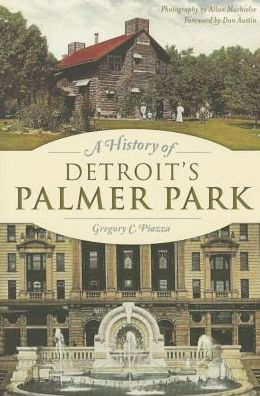A History of Detroit's Palmer Park
Palmer Park is Detroit's underappreciated architectural jewel. Located around the intersection of McNichols Road (Six Mile) and Woodward Avenue, it embraces every style of the late nineteenth and early twentieth centuries. United States senator Thomas Palmer originally developed the property as farmland and donated it to the city in the 1890s. Between 1924 and 1964, its character changed with some of the best examples of modern apartment living from top local architects, including one of just five buildings credited to the world-renowned Albert Kahn. Author Gregory C. Piazza showcases the exceptional story of building Palmer Park.
"1143148858"
Palmer Park is Detroit's underappreciated architectural jewel. Located around the intersection of McNichols Road (Six Mile) and Woodward Avenue, it embraces every style of the late nineteenth and early twentieth centuries. United States senator Thomas Palmer originally developed the property as farmland and donated it to the city in the 1890s. Between 1924 and 1964, its character changed with some of the best examples of modern apartment living from top local architects, including one of just five buildings credited to the world-renowned Albert Kahn. Author Gregory C. Piazza showcases the exceptional story of building Palmer Park.
A History of Detroit's Palmer Park
Palmer Park is Detroit's underappreciated architectural jewel. Located around the intersection of McNichols Road (Six Mile) and Woodward Avenue, it embraces every style of the late nineteenth and early twentieth centuries. United States senator Thomas Palmer originally developed the property as farmland and donated it to the city in the 1890s. Between 1924 and 1964, its character changed with some of the best examples of modern apartment living from top local architects, including one of just five buildings credited to the world-renowned Albert Kahn. Author Gregory C. Piazza showcases the exceptional story of building Palmer Park.
Palmer Park is Detroit's underappreciated architectural jewel. Located around the intersection of McNichols Road (Six Mile) and Woodward Avenue, it embraces every style of the late nineteenth and early twentieth centuries. United States senator Thomas Palmer originally developed the property as farmland and donated it to the city in the 1890s. Between 1924 and 1964, its character changed with some of the best examples of modern apartment living from top local architects, including one of just five buildings credited to the world-renowned Albert Kahn. Author Gregory C. Piazza showcases the exceptional story of building Palmer Park.
21.99
In Stock
5
1

A History of Detroit's Palmer Park
144
A History of Detroit's Palmer Park
144
21.99
In Stock

Product Details
| ISBN-13: | 9781626197848 |
|---|---|
| Publisher: | Arcadia Publishing SC |
| Publication date: | 06/01/2015 |
| Series: | Landmarks |
| Pages: | 144 |
| Product dimensions: | 8.80(w) x 5.90(h) x 0.40(d) |
About the Author
From the B&N Reads Blog
